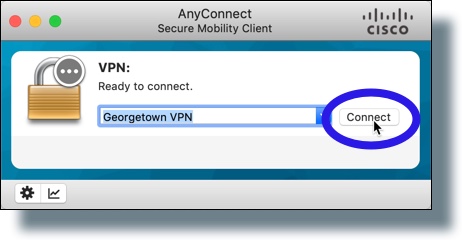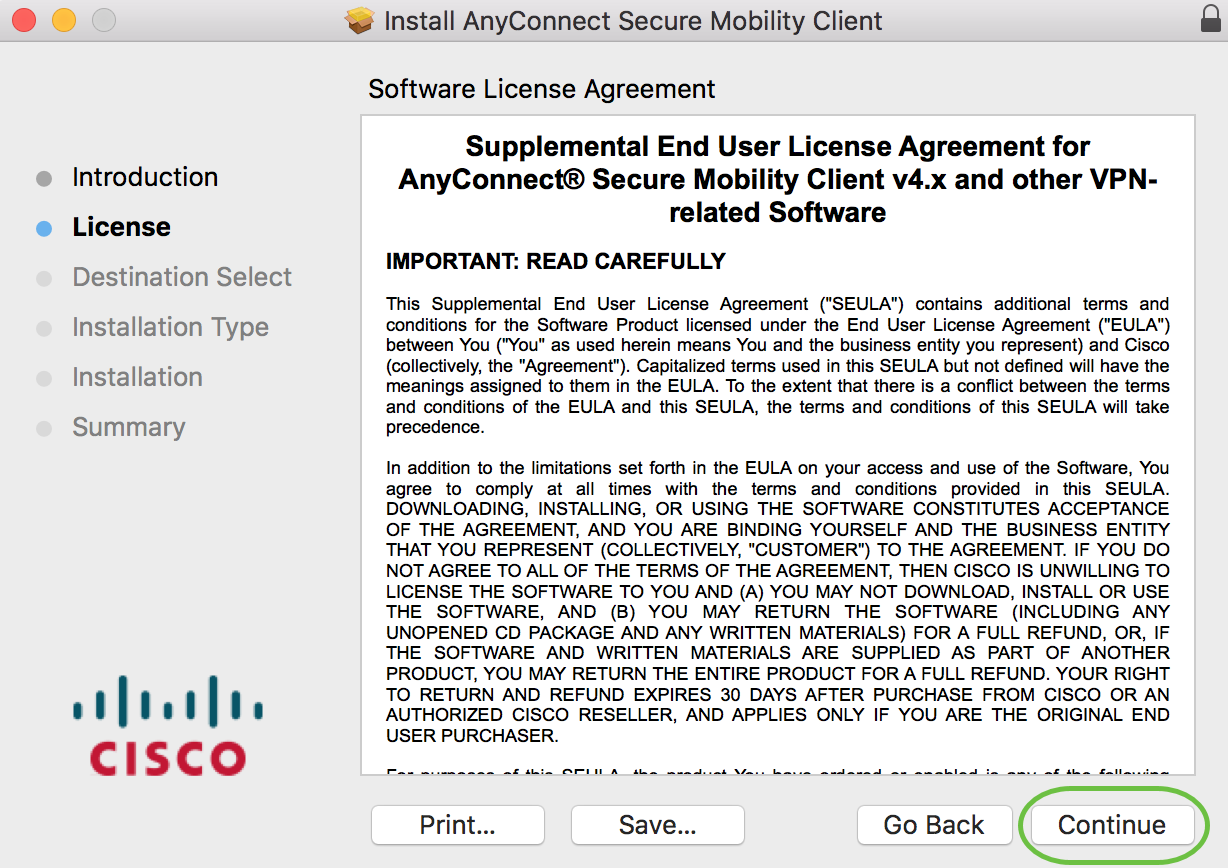Password for the local account on your mac. The client will finish the installation and once completed there will be a Cisco folder in the Applications folder containing the AnyConnect client. Double click on it to start the AnyConnect program. When AnyConnect launches, the server information should already be in place but if not. Sudo pkgutil -forget com.cisco.pkg.anyconnect.vpnType this in the Terminal and Try to REINSTALL THE CISCO ANY COnnect -I cannot install Cisco Anyconne. Installing the VPN Client. Download the AnyConnect VPN client for Mac OS X. In your Downloads folder, double-click the file you just downloaded to open it. An icon will appear on the desktop called AnyConnect, and a separate window will open. Double-click on AnyConnect.mpkg to run the installer, then follow the steps to complete the installation.
Contents
Introduction
This document briefly describes the possible error messages that appear during the installation of AnyConnect VPN client on Apple MAC machines and their corresponding resolutions.
Prerequisites
Requirements
There are no specific requirements for this document.
Components Used

The information in this document is based on these software and hardware versions:
Cisco ASA Security Appliance that runs software version 8.x
Cisco IOS® Router that runs Cisco IOS Software Release 12.4(20)T
Cisco AnyConnect Client software version 2.x
The information in this document was created from the devices in a specific lab environment. All of the devices used in this document started with a cleared (default) configuration. If your network is live, make sure that you understand the potential impact of any command.
Conventions
Refer to Cisco Technical Tips Conventions for more information on document conventions.
Error Messages
This section shows a list of error messages along with the solutions.
Package Corrupt Error Message
When AnyConnect 2.3 is launched from an Apple MAC machine, the Anyconnect Package corrupt or unavailable error message appears and eventually, the connection attempt fails.
Solution
This can be a problem with the absence of the MAC-related AnyConnect package on the flash of the router. Upload the suitable AnyConnect package for MAC in order to resolve this issue. Upload the corresponding AnyConnect package, which depends upon the MAC architecture. For MACs on the Intel processor, you need the i386 macos image and for MACs that run the Power PC processor (PPC) you need the powerpc macos image. These are example packages for your reference:
anyconnect-macosx-i386-2.5.3055-k9.pkg
anyconnect-macosx-powerpc-2.5.3055-k9.pkg
Split DNS Issues
When split DNS is enabled on an AnyConnect setup, it is found that all the DNS queries are sent in clear but not tunneled. This is a problem with only the Apple MAC machines and works fine with Windows machines.
Solution
This behavior is observed and filed in Cisco bug ID CSCtf03894 (registered customers only) . In order to resolve this issue, you can upgrade to the AnyConnect release 3.0.4235, which has the Split DNS Functionality Enhancement. As a workaround, you can also use the built-in IPSec VPN client supported by Apple, which does not have this issue.
SVC Error Message
The launch of AnyConnect from a Macbook Pro running OSX Leopard is not successful. The VPN gateway is ASA running 8.0.4. The connection fails and the SVC Message: 16/ERROR: Initialization failure (mem allocfailed, etc.) error message appears.
Solution
This can be a problem with the way the MAC machine attempts to connect to the ASA. First verify if any IPv6 adaptors are enabled on the MAC machine and check if MAC tries to contact ASA over the IPv6 network. If so, it fails as the IPv6 is not supported with AnyConnect. In order to resolve this, disable the IPv6 related services on the MAC machine and try to connect with an IPv4 address.
Web-based Installation Error Message when AnyConnect is Launched on MAC
There are intermittent issues with you launch the AnyConnect version 2.5 on the MAC with OSX 10.5.6. The web-based installation was unsuccessful error message appears. At that time, you are unable to download and install AnyConnect, and the browser used is Firefox. If you reboot the MAC machine, this fixes the issue temporarily, but intermittently, the issue happens again.
Solution
Verify if your VPN gateways are connected in Load-balancer mode. If it is connected, then there could be some DNS cache-related issues that cause improper DNS redirects. In order to resolve this issue, always try to map the DNS URL to connect to one specific VPN gateway only.
MAC OSX 10.6.3 is Unable to get to Internet
When you use the AnyConnect on a MAC machine, you can access the Internal Corporate network but you are unable to browse to the Internet. It neither works by FQDN nor by IP address. There is a proxy server in use for Internet traffic.
Solution
The issue can be due to the length of the PMTU. Verify the existing MTU size on the VPN gateway, for example, ASA and modify it to a lesser value. In this sample output, the mtu size is reduced to 1204 from existing 1400.
AnyConnect on MAC fails to launch to Cisco IOS Router
The attempt to launch AnyConnect in standalone mode to a Cisco IOS® Router running Cisco IOS Software Release 12.4(20)T is unsuccessful. The anyconnect internal error (state: not connected) error message appears.
Solution
Cisco IOS Software Release 12.4(20)T supports AnyConnect on MAC in standalone mode without any problem. In order to resolve this, try to use the complete URL when you connect to the Cisco IOS head-end device. This is a sample URL:
If this issue persists, contact Cisco TAC (registered customers only) for further troubleshooting.
Note: You need to have valid Cisco user credentials to contact Cisco TAC.
Wireless CSSC for an Apple MAC
Currently, the NAM module on the AnyConnect 3.0 product replaces the Cisco Secure Services Client (CSSC). Refer to Network Access Manager (Replacement for CSSC) for more information. There is no current plan to enable NAM to support MAC OSX platform.
Unable to Upgrade Firefox while AnyConnect is Installed on MAC
This error message appears when you upgrade Firefox on Apple machine version 10.6:
On machines that use softtokens, this error message appears:
It is observed that these MAC machines have AnyConnect version 2.5 installed. The current version of Firefox is 3.6.13.
Solution
This behavior has been tested and filed in Cisco bug ID CSCtn93915 (registered customers only) . As a workaround, you can try any of these described options.

Uninstall AnyConnect, upgrade Firefox and then install AnyConnect again.
Uninstall the current version of firefox then install the new version. All other upgrades after this should work fine.
Web-based Installation of AnyConnect Hangs
The authentication phase works fine but the VPN system hangs at the Using Sun Java for installation phase.
Solution
The issue could be with the Java and Web applet settings on the machine. Sometimes, Java gets stuck when you use the web launch with MAC machine. Refer to Cisco bug ID CSCtq86368 (registered customers only) for more information. In order to resolve this issue, follow the below steps.
Uninstall AnyConnect.
Open Java preferences.
Change to run applets in their own process.
Drag the 32 bit Java on top.
If this does not help, upgrade the AnyConnect client to the latest available release.
Unable to Launch AnyConnect on MAC
You are unable to launch AnyConnect on the MAC machine due to certain incompatible software. What are other options to use this MAC machine as a remote access VPN client?
Solution
Cisco Anyconnect Mac Client Download
Refer to What options do I have for providing remote access to Mac users? for more information. Refer to IPSec VPN client for Apple MAC for more information and complete details.
Unable to Download the MAC AnyConnect Package
There are issues when you download the AnyConnect for MAC software from Cisco.com.
Solution
Open the Cisco AnyConnect VPN Client home page and click on Download Software (registered customers only) on the right hand side of the web page. Choose the required software package and download with valid Cisco user credentials.
Related Information

Setup Cisco Anyconnect Vpn Mac
Install the Cisco AnyConnect software to connect to Cornell's VPN service. You must have administrative privileges to install the software.
Cisco Anyconnect Mac Os
You must have administrative privileges to install the CU VPN software on your computer.Enter the following:
- Connect to https://cuvpn.cuvpn.cornell.edu. The SSL VPN Service Login dialog box will open.
- Enter the following:
Group: Leave this set to CornellVPN
(even if you will be using a departmental VPN after installing AnyConnect).User Name: Enter your Cornell NetID.
Password: Enter your Cornell NetID password.
- A Downloads page will appear after a successful login. It may take a few seconds to a few minutes to collect information about your system.
- If you see two tabs labeled Download and Automatic Provisioning, select . (It's okay if you don't see these tabs.)
- Click .
- Navigate to your default downloads folder and double-click the anyconnect dmg file, then double-click the anyconnect pkg file.
You may be asked to enter an administrative password for your computer. - Follow the on-screen instructions.
If asked, on the Installation Type screen, make sure VPN is selected and everything else is not selected. - If installing on macOS 10.13 (High Sierra) or higher, you may see System Extension Blocked alert. If you see this alert, follow the lettered steps below. Otherwise, continue with step 9 below.
- Click (or ). The System Preferences - Security & Privacy panel will open.
- Next to System software from developer 'Cisco' was blocked from loading click .
- Close the Security & Privacy Panel.
- Click or on the Extension Blocked dialog box.
- Close the installer.
How To Install Cisco Anyconnect On Mac Os X
